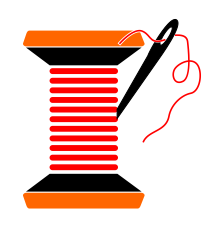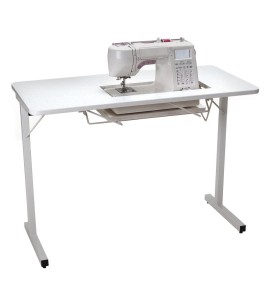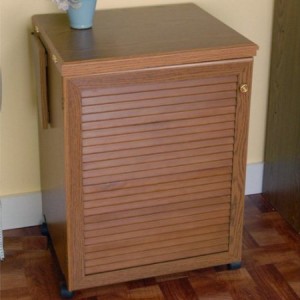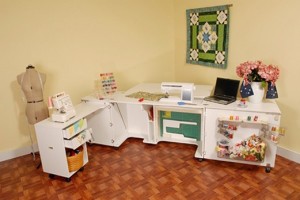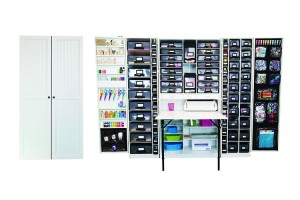You’ve decided its time to take the plunge. No more co-opting the kitchen table; it’s time you had a proper sewing table or cabinet to yourself. Good for you! You made the right decision. Now the fun part comes: choosing just which table will be the new command center for your sewing life. Here we’ll walk you through the process of selecting your sewing table, and when you finish reading this guide, you’ll be as well-informed a shopper as any.
The Ultimate Sewing Table Buyer’s Guide:
A heads up on what all we’ll be covering:
- Key Features To Look for in a Sewing Table or Cabinet
- What to Avoid When Buying a Sewing Table
- Going Compact: Best Choices For Small Spaces
- Surface Area Galore: When You’ve Got All the Room You Need
- In Conclusion: Top Four Points to Remember
Key Features to Look for in a Sewing Table or Cabinet
Shopping for a good sewing cabinet is nothing like shopping for a new kitchen table. With the kitchen table, you want something moderately sturdy, good-looking, and the right size for your kitchen; that’s about it. There are a few other characteristics that might be important to you: heat resistance, maybe; the ability to look good even after children have had their lunches on it: but those features have pretty much become standard on anything marketed as ‘kitchen tables’
Is there any such basic standard with sewing tables and cabinets? Not really. And this is in spite of the fact that the needs of sewers are the same everywhere. Still, you have to be a careful and informed shopper if you don’t want to end up lugging home a piece of junk that simply doesn’t work with your machine.
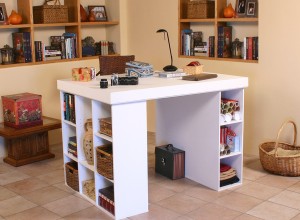
When shopping for a sewing cabinet or cart, here are the top features you should be looking at:
- Stability:
Stability for a sewing table requires a much higher bar than stability in a writing desk or computer table; when your machine goes at high speeds it’ll jolt and shake anything that is not built to handle that kind of stress. A sturdy, quality table is an absolute must.
- Storage:
A minimalistic sewing table with clean, modern lines and lots of empty space underneath may look wonderful, but where are you going to put your half finished project, your thread collection, that extra yard of cute fabric you picked up at JoAnn’s yesterday, and your sewing patterns? If you do decide to go with a no-storage sewing table, make sure you plan adequate crafting storage elsewhere.
- Pneumatic Lift:
This is an option that comes with higher-end sewing cabinets, and you need to decide whether you’re willing to pay the extra dollar for it: a special lift that brings your sewing machine up from its stowaway place in the cabinet up to the tabletop with the flick of a button.
- Surface Area:
At a bare minimum, your sewing table needs enough room to hold your machine. But where do you plan to do your cutting, ironing, basting, and pinning? If you’d like to use your sewing table for that, too, make sure the one you’re looking at will have adequate tabletop room. If you tend to be a clutter bug and like to have all your projects out where you can see them, factor that in as well. And if you do quilting, think about getting a table with a quilting arm; it’ll make your work much easier.
- Assembly:
No, this isn’t really about your future with the table, but your future won’t be able to begin until you’ve got the thing together. Some sewing tables come already assembled, others seem to require a Ph.D. in furniture assembly to even begin to tackle. And then, of course, there is everything in between. Look for a table that meets your ability level; most reasonable furniture should be able to be put together in two or three hours, and require a maximum of two people working together.
What to Avoid When Buying a Sewing Table
We all know the old wisdom when it comes to buying a used car: buy carefully, because you’re better off with no car at all then with a lemon! Sewing tables are the same way. The money you spend on a cheap, worthless table is better not spent at all; you’ll only end up with a bulky piece of furniture you can’t use. Here are some pitfalls you want to avoid when buying.
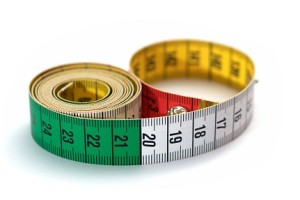
- More Space Than You Can Afford
There’s nothing more annoying than bringing home a beautiful new piece of furniture and then finding it won’t fit in the corner you had planned for it. Measure the space you plan to allot to your sewing table carefully, and check and double check the dimensions of your proposed table before buying.
- Too Heavy To Move
Heavy means quality, right? Not necessarily! A sewing table that weighs a ton is going to be a headache whenever you organize and clean, even if you were foresightful enough to assemble it right in position. Check that the weight of your prospective table is within reasonable limits, or that it is on easy-roll casters otherwise.
- Too Hard to Put Together
This one is obvious; if you can’t get it together, what use is it to you? A box of sewing cabinet parts sitting in your cabinet for six years waiting for a handy someone to volunteer to help you is not doing you any good.
- Not Stable Enough to Run Your Machine
We’ve mentioned this before; a running sewing machine requires a little something extra as far as stability is concerned. Don’t settle for anything less than the best when it comes to sturdy stability.
- Not a Fit for Your Particular Machine
If you’re buying a sewing cabinet with a sewing machine shelf, a table with a flatbed, or a cabinet with a pneumatic lift, you need to check and double-check that it will actually work with the machine you have. All of these things are machine-specific, and there’s no one-size-fits-all.
Going Compact: The Best Choices For Small Spaces
Now you know what to look at when shopping for a generic sewing machine table. But what if you have special needs? For instance, what is the way to go if you’ve got a tiny little studio or apartment, and you’d like to have a sewing room without actually having a sewing room?
You have two main options here. The first is a simple foldaway sewing table. Note, you don’t want any folding table; your average furniture store folding table is not going to be anywhere near stable enough to use a full-powered machine on.
But you can get a nice minimalist sewing table like the Arrow Gidget and fold it flat to put behind your sofa when you’re not working. The Arrow Gidget looks nice, is stable, and provides you with enough work surface for basic sewing. The only downside with this type of sewing solution is that when you’ve put away your table you’ve nowhere to put away your machine, half-finished project, and other sewing notions. You’ll have to have another cabinet to put them away in, and unless you have half-empty cabinets or designated sewing drawers and shelves already, putting in new storage solutions will negate the value of your ‘no-footprint’ table.
The other option is getting a super-compact sewing cabinet that unfolds into a sewing table with the room you want. One beautiful example of this is the Arrow Sewnatra Cabinet —when everything is put away, this cabinet looks like a simple little bureau or even a large nightstand, 23 by 19 5/8 inches and 31 ½ inches wide. The innocent styling makes it disappear in the background in almost any décor scheme. It’s when you open it up that it reveals its glory, as it transforms into a tidy-looking sewing table. The pneumatic lift brings your sewing machine up from its hiding place to whatever height you wish to work, and right there on the door is your thread rack and pockets for your fabric or small projects. No, there’s not a lot of storage, but for the size of this thing you certainly are getting a good deal.
Surface Galore: When You’ve Got All the Room You Need
Compact tables are all very well for those of us in tiny studio apartments. But what about if you’ve built yourself your dream sewing room, and have all the room you need? Then all you need is a table that takes advantage of this space; a table that will provide you with an intense amount of sewing surface area or storage compartments in quantity.
There are two top-runners in this space as well. One is Kangaroo Kabinet’s K8611 Aussie Sewing Cabinet, a sewing station that offers a full 31.5 square feet of table area when it’s fully extended. There’s a nice lift for your sewing machine; a lift which has three different positional options. But that’s just standard stuff: the cool thing about the Aussie is all the room it gives you, not only as surface area, but also for storage. No more working on cluttered, cramped, surfaces, no more trying to stuff more in your drawers than can possibly fit inside. If you have more sewing goodies than can fit in all the drawers, trays and caddies, it just might be time to downsize!
The table folds into a neat sewing cabinet, just under 50 inches wide, 22 inches deep, and 30 inches wide. There are two styles to choose from: teak or white melamine.
If you are such a pack rat that even the Aussie isn’t good enough for you, you may want to look into the Workbox 2.0; a craft table that includes the most extensive storage solutions we’ve seen anywhere. This isn’t a craft table per say, so there’s no lift for your sewing machine, but there is a nice caddy to store it and a solid table to work on. The table top area is just 36 by 24 inches; enough for most projects without being excess; but there are 9 feet (yes, nine feet) of storage space: space which includes a total of 74 canvas drawers on shelves. It’s an organizer-fiend’s paradise, and means you won’t have any excuse, ever, to lose any of your sewing notions again.
If you’ve got the space, there’s no reason to buy tiny, compact sewing tables that are geared for studio life. Test the limits, and buy yourself an extensive sewing table that can make your life simpler, better organized, and more fun!
In Conclusion: Four Points To Remember
Maybe that’s a lot of information to remember, to keep straight in your head the whole time you’re shopping. Here are some take-home points.
1. Check Sizing:
Before you shop, take measurements and jot down some numbers: the amount of room you’ve got in your sewing corner, the size and weight of your machine. Check to make sure the table you want to buy will fit your space, and that your machine will fit on it. Weight comes into account if you’re buying a table with a pneumatic lift.
2. Decide on Storage:
Make sure the sewing cabinet or table you’re planning to buy can hold everything you mean to put it in it; if storage is minimal, make other plans.
3. Do Your Quality Check:
Stability, Sturdiness, Long-life: these are things that won’t come out in the manufacturer’s description, but you should be able to find them fairly easily in user reviews.
4. Don’t Forget Assembly:
This is another good one to check the reviews for; were other buyers able to put the beast together?
If you’ve got that, you’ve pretty much got everything. Of course there’s a bit more to buying your table—you’ll be selecting based on color, style, and aesthetics as well as the practical details—but there you don’t need any schooling. Have fun shopping, and bring home a table that will stay with you through years of comfortable, well-organized sewing!
